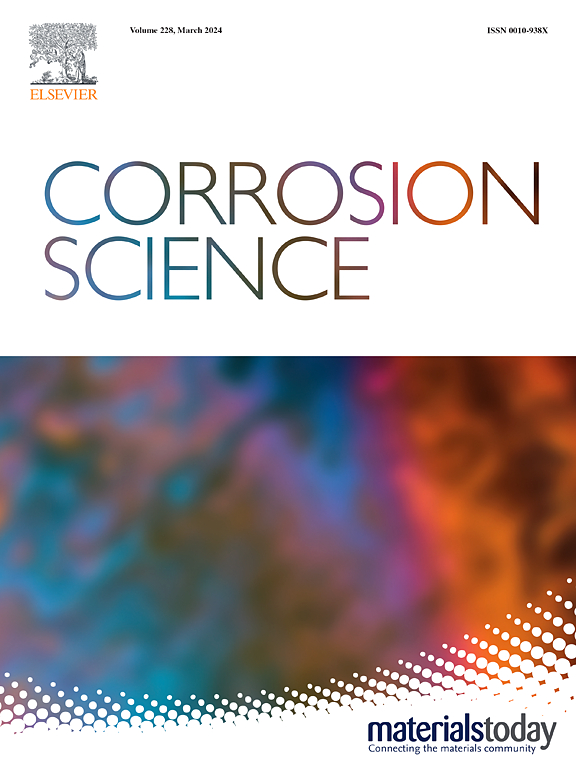激光表面重熔下锻造 Ti-5Al-5Mo-5V-1Cr-1Fe 钛合金的腐蚀行为和微结构对钝化膜机制的影响
IF 7.4
1区 材料科学
Q1 MATERIALS SCIENCE, MULTIDISCIPLINARY
引用次数: 0
摘要
本研究比较了锻造和 LSRed(激光表面重熔)样品,研究了 Ti-5Al-5Mo-5V-1Cr-1Fe (Ti-55511)的腐蚀行为。通过 0.02 毫米的激光间隔进行 LSR,可消除表面宏观缺陷,提高元素均匀性,并将锻造 Ti-55511 表面的初级和次级 α 转化为 β,从而获得比锻造样品更厚、稳定性更高的钝化膜。本研究通过比较相类型、元素均匀性、晶粒大小、形态和缺陷与腐蚀行为的关系,研究了腐蚀机理。电化学腐蚀在模锻样品中占主导地位,α相点蚀加剧,α/β相界面附近氧气积聚,而经过 LSR 处理的样品则出现了 β 晶界腐蚀。本文章由计算机程序翻译,如有差异,请以英文原文为准。
Corrosion behavior and microstructural effects on passivation film mechanisms in forged Ti-5Al-5Mo-5V-1Cr-1Fe titanium alloy under laser surface remelting
This study examines the corrosion behavior of Ti-5Al-5Mo-5V-1Cr-1Fe (Ti-55511), comparing forged and LSRed (laser surface remelting) samples. LSR via 0.02 mm laser interval eliminates surface macro defects, enhances element homogenization, and converts primary and secondary α to β on forged Ti-55511 surface, yielding a thicker passivation film with higher stability than that of as-forged counterpart. This study investigates corrosion mechanisms by comparing the phase type, elemental homogeneity, grain size, morphology, and defects in relation to corrosion behavior. Galvanic corrosion predominates in the as-forged sample, with intensified pitting on the α phase and oxygen accumulation near α/β phase interface, while LSR-treated sample experiences β grain boundary corrosion.
求助全文
通过发布文献求助,成功后即可免费获取论文全文。
去求助
来源期刊

Corrosion Science
工程技术-材料科学:综合
CiteScore
13.60
自引率
18.10%
发文量
763
审稿时长
46 days
期刊介绍:
Corrosion occurrence and its practical control encompass a vast array of scientific knowledge. Corrosion Science endeavors to serve as the conduit for the exchange of ideas, developments, and research across all facets of this field, encompassing both metallic and non-metallic corrosion. The scope of this international journal is broad and inclusive. Published papers span from highly theoretical inquiries to essentially practical applications, covering diverse areas such as high-temperature oxidation, passivity, anodic oxidation, biochemical corrosion, stress corrosion cracking, and corrosion control mechanisms and methodologies.
This journal publishes original papers and critical reviews across the spectrum of pure and applied corrosion, material degradation, and surface science and engineering. It serves as a crucial link connecting metallurgists, materials scientists, and researchers investigating corrosion and degradation phenomena. Join us in advancing knowledge and understanding in the vital field of corrosion science.
 求助内容:
求助内容: 应助结果提醒方式:
应助结果提醒方式:


